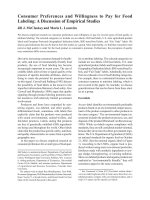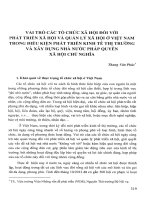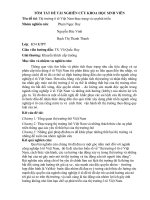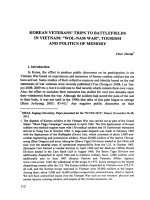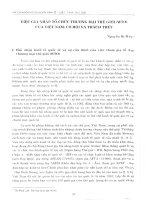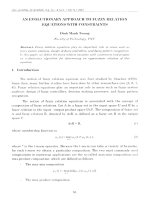DSpace at VNU: Preference and willingness to pay for traditional medicine services in rural ethnic minority community in Vietnam 6.Nguyen Hoang Long
Bạn đang xem bản rút gọn của tài liệu. Xem và tải ngay bản đầy đủ của tài liệu tại đây (442.03 KB, 8 trang )
Tran et al. BMC Complementary and Alternative Medicine (2016) 16:48
DOI 10.1186/s12906-016-1010-7
RESEARCH ARTICLE
Open Access
Preference and willingness to pay for
traditional medicine services in rural ethnic
minority community in Vietnam
Bach Xuan Tran1,2*, Ngan Kim Nguyen4, Lan Phuong Nguyen3, Cuong Tat Nguyen5, Vuong Minh Nong1
and Long Hoang Nguyen6
Abstract
Background: Traditional medicine (TM) still plays an important role in a number of health care systems around the
world, especially across Asian and African countries. In Vietnam, however, little is known about preference for
traditional medicine use. This study assessed the prevalence of use, preference, satisfaction, and willingness to
pay for TM services amongst rural ethnic minority community.
Methods: A cross-sectional survey in three provinces in the North and South of Vietnam.
Results: The results showed a high level of satisfaction with TM services, with more than 90 % of respondents
reporting improved health status given the use of TM. Indicators for preference of TM over modern medicine are
a longer distance to health station; being in an ethnic minority; being female; and having had higher service satisfaction.
Although we did not have a comparison group, the high level of satisfaction with TM services is likely the result of a
project targeting community health workers and the public regarding TM education and access promotion. Indeed, the
community health workers are credited with relaying the information about TM more than any other sources. This
suggests the importance of community health workers and community health centers in the promotion of TM use.
Conclusions: Ethnic minority people prefer the use of traditional medicine services that supports the expansion of
national programs and promotion of traditional medications.
Background
Traditional medicine (TM) is defined as “the sum total of
the knowledge, skills, and practices based on the theories,
beliefs, and experiences indigenous to different cultures,
whether explicable or not, used in the maintenance of
health as well as in the prevention, diagnosis, improvement
or treatment of physical and mental illness” [1]. TM’s use
is widespread not only in developing countries of Africa,
Asia and Latin America but also in developed countries.
The prevalence of TM use by general populations was
higher in East Asian countries (South Korea: 45.8–69 %,
China: 90 % or Lao PDR: 77 %) [2–4] in comparison with
developed countries with around 50 % in Australia, 42 % in
* Correspondence:
1
Institute for Preventive Medicine and Public Health, Hanoi Medical
University, Hanoi, Vietnam
2
Johns Hopkins Bloomberg School of Public Health, Johns Hopkins
University, Baltimore, MD, USA
Full list of author information is available at the end of the article
USA and 49 % in France [5]. Higher TM use was found to
be associated with female [6, 7], higher level of education
[6, 8–12], higher age [7], and poorer health status [7, 13].
The preference for TM and its reasons were diverse
across regions. In both developed and developing world,
for example, Uganda, Ethiopia, and the United States, there
was about 45 to 70 % people more likely to choose traditional medical care than western medicine [10, 11, 14].
Among those given preference for TM, they highly appreciated its affordability, accessibility, and acceptability [14].
However, the choice of patients and treatment outcomes
using TM differed significantly between patient groups
with different diseases [15]. A review of TM in European
countries showed that the majority of patients who chose
to use TM had experienced ineffective and dissatisfied conventional treatments using western medicine [16]. In
addition, the use of TM was associated with awareness of
patients, availability of services and coverage of communication campaigns on TM [13, 17, 18].
© 2016 Tran et al. Open Access This article is distributed under the terms of the Creative Commons Attribution 4.0
International License ( which permits unrestricted use, distribution, and
reproduction in any medium, provided you give appropriate credit to the original author(s) and the source, provide a link to
the Creative Commons license, and indicate if changes were made. The Creative Commons Public Domain Dedication waiver
( applies to the data made available in this article, unless otherwise stated.
Tran et al. BMC Complementary and Alternative Medicine (2016) 16:48
Vietnam is located on the eastern rim of the Indochina
peninsula in the South East Asian tropical monsoon zone.
The country has a long history of traditional medicine
which was formed throughout thousands of years of national construction and defence [19]. The government of
Vietnam regards TM as one of national cultural inheritances needed to be preserved and developed. In 2010,
Government issued the Master Action Plan on development of TM up to 2020 to boost the TM development and
usage [20]. However, people in mountainous and difficult
areas still had limited access to TM because of various factors including their limited knowledge and awareness on
TM; sparse population distribution on difficult-to-reach
terrains; long distance to the health centre; and unsatisfactory service (Tran Xuan Bach, Nong Minh Vuong, Cuong
NT: Post-implementation evaluation of the model using
traditional medicine kits in selected communes in Vietnam,
Unpublished work).
Although there were several studies that examined TM
use in the world, the limited scientific evidence regarding
awareness and preference of TM make it important to
conduct research specific in Vietnam. This paper aims to
assess preference and awareness of traditional medicine
use as well as the satisfaction for TM services among
people in mountainous and difficult areas. The results can
also serve to inform future research direction into traditional medicine in Vietnam [21].
Methods
Study setting, study subjects and sample size
This cross-sectional study was conducted in three provinces including Hoa Binh, Quang Ninh and Dong Nai.
Two communes in resource-limited settings of each
province were purposively selected for the survey. These
communes are all in mountainous or remote areas and
have a distance of 10 to 40 km away from a district
health centre. We randomly selected 5 villages in each
commune from which we conveniently select 10 households, making a total of 50 households per commune.
Measurements and data collection
We conducted face-to-face interviews using a structured
questionnaire to collect information about socioeconomic,
awareness, TM services utilization, knowledge, attitude
and practice of using TM among respondents. We also
asked the preference and willingness to pay for TM kit,
which was assumed to include from ten to twenty varieties
of Vietnamese TM (for some common diseases such as
cold, fever, diarrhea, muscle pain, etc), several small medical equipment such as thermometer, cotton gauze, bandages, and a guidebook.
Perceived health improvement by traditional medicine,
self-evaluated knowledge and competency on traditional
medicine use were measured using a five-level scale ranging
Page 2 of 8
from 1 to 5. Participant’s satisfactions with services quality
included 10 questions on which respondents rated on a 10point scale, namely: 1) overall satisfaction with general services at commune health station, 2) overall satisfaction with
TM services, 3) access to information, 4) consultation, explanation, and guidance, 5) convenient in using TM, 6)
convenience in combining traditional and western medicine, 7) inter-professional collaborations at health stations,
8) competence - and 9) responsiveness of TM doctors and
health workers 10) availability of demanding TM services.
Well-trained interviewers, who are master students at
Hanoi Medical University, with supports by village health
workers, visited households and invited family head or any
other people at home to participate in the survey.
Data analysis
We used Stata 12.0 to produce both descriptive and analytical statistics. A p-value of less than 0.05 was considered statistical significance. We used censored regression
model to find the significant predictors of preference for
and health improvement by TM services.
Ethical consideration
The Scientific Research and Ethics Committee of National
Occupational and Environmental Health approved the
protocol. We obtained written informed consent from all
participants after clearly introducing the survey. Respondents could refuse to participate or withdraw from the
interview at any time, and this did not affect their continuation of services. Confidentiality was assured using codes
of their information, and secured storage was prepared for
both paper questionnaires and electronic data set.
Results
Table 1 presents characteristics of respondents participated in the study. The mean age of all participants was
46.5 (SD = 13.0); 64.7 % were female; 40.7 % had secondary school education and above. There were 56.4 % respondents who reported a distance over 2 km to the commune
health station.
Table 2 presents services utilization characteristics, participants’ self-evaluation of knowledge and skills on TM,
and perceived health improvements by gender. We found
that the major source of information about traditional
medicine included community health workers (90.3 %),
followed by relatives, neighbours or friends (26.3 %). The
media (TV, newspaper) and traditional healers (including
pharmacies that specialize in medical herbs) play less
prominent roles in dispersing information on TM, accounting for 9.7 and 8.7 % of the information gained respectively. There were 61.4 % men and 55.3 % women who
reported that they had levels of very good or good of
knowledge and skills on the use of traditional medicine for
their health care. About 91.6 % of respondents reported
Tran et al. BMC Complementary and Alternative Medicine (2016) 16:48
Page 3 of 8
Table 1 Characteristics of respondents in three provinces
HoaBinh
QuangNinh
Dong Nai
p
Total
Mean
SD
Mean
SD
Mean
SD
Mean
SD
42.6
13.6
47.2
13.9
50.7
11.9
46.5
13.0
N
%
N
%
N
%
N
%
54
54.0
70
70.0
70
70.0
194
64.7
20–30
24
24.0
12
12.0
6
6.0
42
14.0
31–40
17
17.0
22
22.0
16
16.0
55
18.3
41–50
34
34.0
29
29.0
21
21.0
84
28.0
41–60
17
17.0
19
19.0
37
37.0
73
24.3
> 60
8
8.0
18
18.0
20
20.0
46
15.3
Primary school
38
38.0
36
36.0
62
62.0
136
45.3
Secondary school
45
45.0
28
28.0
16
16.0
89
29.7
High school and above
11
11.0
9
9.0
13
13.0
33
11.0
Others
6
6.0
27
27.0
9
9.0
42
14.0
Mean age
Female
Age groups
<0.001
<0.05
<0.001
Educational attainment
<0.001
Number of family members
1 to 2
6
6.0
24
24.0
25
25.0
55
18.3
3 to 4
44
44.0
44
44.0
48
48.0
136
45.3
>= 5
59
59.0
32
32.0
27
27.0
118
39.3
Average income (VND)
<0.001
0.0
< 20 millions
41
41.0
51
51.0
12
12.0
104
34.7
20–60 millions
57
57.0
40
40.0
64
64.0
161
53.7
> 60 millions
2
2.0
9
9.0
24
24.0
35
11.7
<0.001
Distance to health community station
< 1 km
16
16.0
28
28.0
3
3.0
47
15.6
1–2 km
34
34.0
37
37.0
13
13.0
84
28.0
> 2 km
50
50.0
35
35.0
84
84.0
169
56.4
that they perceived an improvement in their health status
given the use of traditional medicine. Almost two thirds of
participants (66.3 %) claimed that with TM, they were
“much better, but not completely cured”. Only 11.3 %
claimed that they were completely cured; while others reported feeling “a little bit better” (14 %), “unknown” (6 %),
or “not better but not worse” (2.3 %).
In Table 3, we found that respondents were highly satisfied with all criteria of quality of the traditional medicine
services, indicated by scores over 8 in a 10-point rating
scale. Men reported slightly higher levels of satisfaction on
traditional medicine services than women across all ten
dimensions of the services quality measure, and are also
willing to pay more. On average, men would pay for about
VND 589,000 (~ USD 28) and women would pay VND
approximately 120,000 (~USD 6) for one-year use of the
traditional medicine box with multiple refills. Two thirds
of respondents have a preference for traditional medical
care over modern medicine.
<0.001
In Table 4, we identified factors associated with the
participants’ preference for traditional over modern
medicine and perceived health improvement given the
use of traditional medicine. We found that respondents
who were Muong people (vs. Kinh people), female, more
competent in traditional medicine use, or who had longer distance to commune health station reported higher
preference traditional medicine than their counterparts.
In addition, services satisfaction was significantly related to
the preference for traditional medicine. Particularly, respondents with higher satisfaction with traditional medical
care services, who experienced convenience when using
traditional medicine box, or who thought that their traditional medicine doctors were responsive, were more likely
to choose traditional medicine rather than western medicine. Adjusting for other covariates, we found that perceived health improvement was a strong predictor of
respondents’ preference for traditional medicine. In censored regression model, we found that health improvement
Tran et al. BMC Complementary and Alternative Medicine (2016) 16:48
Page 4 of 8
Table 2 Services utilization and self-evaluated knowledge and skills on traditional medicine by sex
Male
Female
p
Total
Source of Traditional medicine information
N
%
N
%
N
%
— Community health workers
99
93.4
172
88.7
271
90.3
0.18
— Traditional healers
8
7.5
18
9.3
26
8.7
0.61
— TV/paper
15
14.2
14
7.2
29
9.7
0.89
— Relatives, neighbors or friends
25
23.6
54
27.8
79
26.3
0.42
Traditional Medicine Package Use
Mean
SD
Mean
SD
Mean
SD
— Frequency of use (times/year)
6.74
5.3
5.73
3.5
6.1
4.2
0.03
— Frequency of refiling the traditional medicine
3.03
2.6
2.81
2.2
2.89
2.3
0.22
Self-evaluated knowledge on traditional medicine use
N
%
N
— Very good
15
14.2
13
6.7
28
9.3
— Good
50
47.2
94
48.5
144
48.0
— Moderate
27
25.5
71
36.6
98
32.7
— Poor
11
10.4
16
8.3
— Very poor
3
2.8
Self-evaluated skills on traditional medicine use
N
%
N
N
%
— Very Competent
16
15.1
16
8.3
32
10.7
— Fairly Competent
48
45.3
93
47.9
141
47.0
— Moderately Competent
31
29.3
63
32.5
94
31.3
— Little competent
8
7.6
21
10.8
29
9.7
— Not at all Competent
3
2.8
1
0.5
4
1.3
%
%
%
N
%
27
9.0
3
1.0
Perceived health improvement by traditional medical use
N
%
N
N
%
— Completely cured
15
14.2
19
9.8
34
11.3
— Much better but not completely cured
67
63.2
132
68.0
199
66.3
— A little bit better
20
18.9
22
11.3
42
14.0
— Not better but not worse
0
0.0
7
3.6
7
2.3
— Unknown
4
3.8
14
7.2
18
6.0
given traditional medicine use was positively associated
with higher education, knowledge on traditional medicine
and its ease to use; whereas it was negatively associated
with longer distance to commune health stations.
Discussion
This study offers some insights into the awareness and
preference of traditional medicine services in three rural,
mountainous provinces of Vietnam: Hoa Binh, Quang
Ninh, and Dong Nai. Except for Phu Ly, the communes
selected in these provinces share the same characteristic
of having at least a third of their population living in
poverty. In Hoa Binh, ethnic minority groups make up
more than 70 % of total population, in which 63.4 % is
Muong, followed by Thai (3.9 %), Tay (2.7 %), Dao, and
H’Mong. Selected communes are located at a distance of
10 to 40 km away from the district health center, which
hints at difficulties in getting access to health care and
subsequent low uptake of service [22].
0.01
0.14
<0.001
Knowledge and skills in traditional medicines
Results show that community health care workers play
an integral part in imparting knowledge in traditional
medicine, and thus may take credits for their high selfevaluated knowledge and skills in traditional medicines.
Friends, family and neighbors are also an important source
for knowledge, possibly because participants live in small,
rural communities, where social ties are deeper and words
of mouth have a major influence in which services people
choose to use [23].
Both the media and traditional healers do not seem to
be major factors in people’s knowledge of traditional medicines. In this study, “traditional healers” include pharmacies that specialize in medicinal herbs, and while these
facilities may have more influence over information on
TM in other countries in Asia, they seem to have the least
impact in distributing this information in the study.
These results likely indicate the early outcomes of the
Traditional Medicines project, which aimed at building
capacity for community health care workers and promote
Tran et al. BMC Complementary and Alternative Medicine (2016) 16:48
Page 5 of 8
Table 3 Respondents’ satisfaction and willingness to pay for traditional medicine services by sex
Male
Female
p
Total
Satisfaction on TM services
Mean
SD
Mean
SD
Mean
SD
— Overall satisfaction with general services quality at commune health station
8.83
1.10
8.75
1.15
8.78
1.13
0.28
— Overall satisfaction with traditional medical services quality
8.36
1.33
8.04
1.54
8.15
1.47
0.03
— Access to informations about TM
8.88
1.12
8.64
1.24
8.73
1.20
0.05
— Consultation, explanation, and guidance on TM use by health workers
8.79
1.19
8.68
1.23
8.72
1.22
0.23
— Convenience in using traditional medicine package
9.12
1.03
9.10
1.02
9.11
1.02
0.44
— Convenience in combining traditional and western medicine
8.76
1.13
8.49
1.28
8.59
1.24
0.03
— Inter-professional collaborations at health stations
8.66
1.09
8.32
1.36
8.44
1.28
0.01
— Competence of TM doctors and health workers
8.48
1.24
8.10
1.39
8.23
1.35
<0.001
— Responsiveness of TM doctors and health workers
8.76
1.11
8.67
1.35
8.71
1.27
0.28
0.47
— Availability of demanding TM services
8.32
1.50
8.30
3.40
8.30
2.87
Willingness to pay for TM package
N
%
N
%
N
%
— Willing to pay
100
94.3
171
88.1
271
90.3
— Not willing to pay
6
5.7
23
11.9
29
9.7
Mean
SD
Mean
SD
Mean
SD
589.13
3146.86
119.94
115.06
289.88
1902.98
N
%
N
%
N
%
6
5.7
75
38.7
81
27.0
Mean price (thousand VND)
<100 thousand VND
100–300 thousand VND
65
61.3
70
36.1
135
45.0
>300 thousand VND
35
33.0
49
25.2
84
28.0
N
%
N
%
N
%
64
60.4
133
68.9
197
65.9
Preference for traditional medicine over modern medicine
knowledge among the community on traditional medicines. A vast scientific literature has regarded community
health workers as an integral part of the health care system
[24–26], especially in low and middle-income countries.
They serve as health extenders [25], natural healers who
build rapport, trust, and understanding between the patients and the health care system [24], and important
members of the health care workforce who enhance the
quality of life for people in poor, marginalized, and underserved area [25]. The results of this study corroborate
the literature claim of community health workers’ role
in a subdomain of the health care system: traditional
medicine. When it comes to health promotion, the
rural, mountainous setting of the three provinces in the
study calls for community health workers’ mobility, accessibility and local knowledge, thus it is crucial to tap
on this resource. Community health care workers when
described in this context are usually based in community health centers, which reiterate the importance of
these facilities in providing care to populations living in
the rural, mountainous areas.
Willingness to pay
The participants’ high willingness to pay carries more significance if we consider the percentage of participants in
0.08
0.03
<0.001
0.14
this study who live in poverty (at least 30 %, except for
Phu Ly). There was no data related to social or health
insurance coverage for these participants, thus it is not
clear whether they will be reimbursed for these purchases. It suggests that they think the traditional medicine box is good value for money for their households.
Logistics may serve as another reason for the willingness to pay. Literature has indicated that long distance
to health facilities acts as a clear-cut barrier to people’s
service utilization [22]. Therefore, besides the perceived
good quality of traditional medicine services, the lack
of frequent access to health facilities may serve as yet
another motivator for people to obtain a traditional
medicine box, since it would potentially spare them the
trouble of going back to the district health center every
time they have an ailment.
The fact that men were willing to pay more for this
medicine box may bear several possible explanations:
men’s financial authority in the household, especially in
the countryside of Vietnam, where patriarchal ideologies
still pertain; women’s tendency to be more economical
as the role of the family “caretaker”. It would be interesting to explore this discrepancy in willingness to pay and
how gender plays a role in men’s and women’s behaviors
in spending for traditional medicine.
Tran et al. BMC Complementary and Alternative Medicine (2016) 16:48
Page 6 of 8
Table 4 Factors associated with preference for and health improvement by traditional medical services
Prefer traditional over modern
medicine
Perceived health improvement
by traditional medicine
OR
Coef
95 % CI
0.29
−0.02
0.59
0.25
−0.02
0.51
0.29*
0.06
0.52
95 % CI
% Spending on health care
Lowest (ref)
Moderate
High
Ethnics: Muong vs. Kinh
2.22*
1.05
4.72
Sex: female vs. male
2.27*
1.09
4.72
Education: Secondary school and above vs. below
Distance to health station
< 1 km (ref)
−0.20
−0.49
0.10
−0.30*
−0.58
−0.01
−0.23
−0.47
0.01
0.24*
0.10
0.37
0.16*
0.02
0.30
— Inter-professional collaborations at health stations
−0.15
−0.32
0.02
— Competence of TM doctors and health workers
0.11
−0.03
0.26
1.98
0.92
3.04
1–2 km
> 2 km
2.17*
1.10
4.29
Knowledge on TM use
0.50
0.21
1.22
Competency on TM use
2.44*
0.99
6.01
Perceived health improvement given TM use
1.65*
1.02
2.75
— Overall satisfaction with general services quality at commune health station 0.68
0.41
1.12
— Overall satisfaction with traditional medical services quality
1.72*
1.10
2.67
— Consultation, explanation, and guidance on TM use by health workers
0.60
0.34
1.07
— Convenience in using traditional medicine package
1.81*
0.99
3.31
— Convenience in combining traditional and western medicine
0.70
0.44
1.14
Health problems: Yes vs. No
Services Satisfaction
— Responsiveness of TM doctors and health workers
Constant
1.62*
1.01
2.68
* p < 0.05
Preference
We observe that the Muong people, an ethnic minority,
are twice more likely to prefer traditional over modern
medicine. Literature has shown the importance of traditional spiritual beliefs among ethnic minorities in daily
life in general and health care in particular [27].
Various studies in the South East Asia and East Asia
region have also indicated high prevalence of traditional
medicine use among ethnic minorities [28, 29]. However,
we lack data that indicates whether ethnicity is a clear
predictor of the preference of traditional over modern
medicine in the region. Logistics is again a deciding factor in people’s choice, since those who live farther away
(>2 km) from a commune health center tend to choose
traditional medicine services (OR = 2.17; 95 % CI 1.10–
4.29), where they can subsequently take up a medicine
box for use at home.
Perceived health improvement is imperative and is predicted by participants’ knowledge of traditional medicine
and its simplicity to use. These ‘convenience’ and ‘simplicity’ characteristics suggest that traditional medicine are
most likely used for self-management of existing medical
conditions and health maintenance. Studies on traditional
medicines in Uganda and Malaysia [28] both indicate the
same result. In a study by Jung Hwang et al. on the
utilization of traditional medicine among ethnic minorities
in South Korea [29], it is found that traditional medicine
is most frequently employed in treating cold, fatigue, stomach pain, and joint pain. In Vietnam, self-management of
diseases is also recorded and we observed that TM was
used to treat back pains, headache, cold, flu, joint pain, inflammation and digestive disorders, which were the common diseases in population.
It is worthwhile to note that this study only looks at the
preference of traditional medicine over modern medicine,
and not looking at them as complementary. In the same
study by Hwang et al., it was found that 55 % of the participants felt that traditional medicine was effective or that
Tran et al. BMC Complementary and Alternative Medicine (2016) 16:48
the combination of conventional (modern) and traditional
medicine was more effective than conventional medicine
alone. The same results were found in a study on traditional medicine use in Mongolia, with 38 % combined use
[30]. It would be interesting to look more into this behavior of respondents in future studies.
Policy implications
This study shows the importance of community health
centers in general and community health care workers in
particular in dispersing information and awareness on
traditional medicine to people in rural and mountainous
areas. The community health centers can serve as hubs
where people can get reliable information on traditional
medicine purchase the medicine box for home use, and
consult physicians or pharmacists about their usage of
traditional medicine. This suggests the need to invest in
building and maintaining community health care centers,
as well as to support community health care workers financially (through salary and allowance) and professionally (through training and technical assistance) if we want
to promote traditional medicine in these rural areas. Community network is also a crucial channel to relay information about traditional medicine health services, as shown
in the study. A community awareness component therefore should be put in place once services have been established to ensure people get another sources of information
on traditional medicine [31].
Additionally, while people indicated the high effectiveness of TM, health workers should provide more knowledge and skills about how to use TM appropriately.
Some evidences suggested adverse effects of TM, especially in treating infectious diseases due to the nature of
TM and the infections [32, 33]. Therefore, the instruction of health workers had a central role to improve the
impact of TM on health status of population.
As observed in the study, the convenience feature of
the traditional medicine box was highly appreciated by
participants, and is worth noting to implement further
interventions of TM kit provision for this population.
This study also suggests further research on the willingness to pay for traditional medicine and the role of insurance in defraying this cost.
Strength and weakness of study
This is one of the first studies to look at traditional medicine use in rural, mountainous parts of Vietnam, and also
the first to explore the awareness and preference of traditional over modern medicine. Although the results of this
study strongly suggest the initial impact of the traditional
medicine promotion project on people’s high awareness of
preference regarding TM, we cannot draw causal inference due to the lack of a comparison group. The sampling
Page 7 of 8
method employed in this study also may lead to lack of
representation from disenfranchised groups in rural areas.
Conclusion
In conclusion, we found a strong preference and willingness of respondents to use and to pay for TM in rural
areas of Vietnam. Strengthening TM service quality and
availability, improving the convenience in TM use and
increasing awareness and skills of local people are necessary to promote TM in primary health care.
Competing interests
The authors declare that they have no competing interests.
Authors’ contributions
BXT, VMN, CTN designed and implemented the study. BXT and VMN
analyzed the data. BXT, NKN, LPN, VMN, CTN and LHN wrote the manuscript.
All authors read and approved the final manuscript.
Acknowledgments
We thank local health authorities in study settings, all collaborators,
researchers and supported who were involved in this study.
Author details
1
Institute for Preventive Medicine and Public Health, Hanoi Medical
University, Hanoi, Vietnam. 2Johns Hopkins Bloomberg School of Public
Health, Johns Hopkins University, Baltimore, MD, USA. 3T.H.Chan School of
Public Health, Harvard University, Cambridge, USA. 4Department of
Epidemiology, Hanoi School of Public Health, Hanoi, Vietnam. 5Institute for
Global Health Innovations, Duy Tan University, Da Nang, Vietnam. 6School of
Medicine and Pharmacy, Vietnam National University, Hanoi, Vietnam.
Received: 11 August 2015 Accepted: 22 January 2016
References
1. World Health Organization: Traditional Medicine: Definitions [http://www.
who.int/medicines/areas/traditional/definitions/en/]. Accessed 1 Sep 2015
2. Shin HK, Jeong SJ, Huang DS, Kang BK, Lee MS. Usage patterns and adverse
experiences in traditional Korean medicine: results of a survey in South
Korea. BMC Complement Altern Med. 2013;13:340.
3. World Health Organization. Regional Strategy for Traditional Medicine in the
Western Pacific. Geneva, Switzeraland: World Health Organization; 2002.
4. Sydara K, Gneunphonsavath S, Wahlstrom R, Freudenthal S, Houamboun K,
Tomson G, et al. Use of traditional medicine in Lao PDR. Complement Ther
Med. 2005;13(3):199–205.
5. Bodeker G, Kronenberg F. A public health agenda for traditional, complementary,
and alternative medicine. Am J Public Health. 2002;92(10):1582–91.
6. Hughes GD, Aboyade OM, Clark BL, Puoane TR. The prevalence of traditional
herbal medicine use among hypertensives living in South African
communities. BMC Complement Altern Med. 2013;13:38.
7. Hughes GD, Puoane TR, Clark BL, Wondwossen TL, Johnson Q, Folk W.
Prevalence and predictors of traditional medicine utilization among persons
living with AIDS (PLWA) on antiretroviral (ARV) and prophylaxis treatment in
both rural and urban areas in South Africa. Afr J Tradit Complement Altern
Med. 2012;9(4):470–84.
8. Kew Y, Chia YL, Lai SM, Chong KY, Ho XL, Liew DW, et al. Traditional and
Complementary Medicine (TCM) among Study Population with Cardiovascular
Risk; use and Substitution for Conventional Medicine in Pahang, Malaysia. Med
J Malaysia. 2015;70(2):86–92.
9. Seo HJ, Baek SM, Kim SG, Kim TH, Choi SM. Prevalence of complementary
and alternative medicine use in a community-based population in South
Korea: a systematic review. Complement Ther Med. 2013;21(3):260–71.
10. Galabuzi C, Agea JG, Fungo BL, Kamoga RMN. Traditional medicine as alternative
form of health care system: A preliminary case study of nangabo sub-county,
central Uganda. Afr J Tradit Complement Altern Med. 2009;7(1):11–6.
11. Oldendick R, Coker AL, Wieland D, Raymond JI, Probst JC, Schell BJ, et al.
Population-based survey of complementary and alternative medicine usage,
Tran et al. BMC Complementary and Alternative Medicine (2016) 16:48
12.
13.
14.
15.
16.
17.
18.
19.
20.
21.
22.
23.
24.
25.
26.
27.
28.
29.
30.
31.
32.
33.
patient satisfaction, and physician involvement. South Carolina
Complementary Medicine Program Baseline Research Team. South Med
J. 2000;93(4):375–81.
Hanssen B, Grimsgaard S, Launso L, Fonnebo V, Falkenberg T, Rasmussen
NK. Use of complementary and alternative medicine in the Scandinavian
countries. Scand J Prim Health Care. 2005;23(1):57–62.
Gyasi RM, Mensah CM, Siaw LP. Predictors of traditional medicines
utilisation in the Ghanaian health care practice: interrogating the Ashanti
situation. J Community Health. 2015;40(2):314–25.
Misha G, Yarlagadda R, Wolde-Mariam M. Knowledge, Attitude, Practice and
Management of Traditional Medicine among People of Shopa Bultum,
Southeast Ethiopia. Res J Pharmaceut Biol Chem Sci. 2014;5(5):152–70.
Tovey P, Broom A, Chatwin J, Hafeez M, Ahmad S. Patient assessment of
effectiveness and satisfaction with traditional medicine, globalized
complementary and alternative medicines, and allopathic medicines for
cancer in Pakistan. Integr Cancer Ther. 2005;4(3):242–8.
Eardley S, Bishop FL, Prescott P, Cardini F, Brinkhaus B, Santos-Rey K, et al. A
systematic literature review of complementary and alternative medicine
prevalence in EU. Forsch Komplementmed. 2012;19 Suppl 2:18–28.
Stanifer JW, Patel UD, Karia F, Thielman N, Maro V, Shimbi D, et al. The
determinants of traditional medicine use in Northern Tanzania: a mixedmethods study. PLoS One. 2015;10(4):e0122638.
Koirala RR, Khaniya BN, Singh SP, Aryal KK, Bhusal CL. Quality and effectiveness
of service provision of traditional medicine based health service centres in
Kathmandu, Nepal. J Nepal Health Res Counc. 2013;11(24):177–81.
Ladinsky JL, Volk ND, Robinson M. The influence of traditional medicine in
shaping medical care practices in Vietnam today. Soc Sci Med. 1987;25(10):
1105–10.
Chuc NTK. Identification of Priority Policy Research Questions in the area of
Access to and Use of Medicines in Vietnam. Hanoi, Vietnam: Hanoi Medical
University; 2011.
Van Vo T, Hoat LN, Jan van Schie T. Situation of the Kinh poor and minority
women and their use of the Maternal Care and Family Planning Service in
Nam Dong Mountainous District, Thuathien-Hue Province, Vietnam. Rural
Remote Health. 2004;4(4):255.
Toan NV, Trong LN, Hojer B, Persson LA. Public health services use in a
mountainous area, Vietnam: implications for health for policy. Scand J
Public Health. 2002;30(2):86–93.
United Nations Population Fund, UNFPA APRO. Socio-cultural influences on
the reproductive health of migrant women: a review of literature in
Cambodia, Lao PDR, Thailand, and Vietnam. Bangkok, Thailand: United
Nations Population Fund, UNFPA APRO; 2011.
Braun R, Catalani C, Wimbush J, Israelski D. Community health workers and
mobile technology: a systematic review of the literature. PLoS One. 2013;
8(6):e65772.
Herman AA. Community health workers and integrated primary health care
teams in the 21st century. J Ambul Care Manage. 2011;34(4):354–61.
Rosenthal EL, Brownstein JN, Rush CH, Hirsch GR, Willaert AM, Scott JR, et al.
Community health workers: part of the solution. Health Aff (Project Hope).
2010;29(7):1338–42.
Gerdner LA, Cha D, Yang D, Tripp-Reimer T. The circle of life: end-of-life care
and death rituals for Hmong-American elders. J Gerontol Nurs. 2007;33(5):
20–9. quiz 30-21.
Siti ZM, Tahir A, Farah AI, Fazlin SM, Sondi S, Azman AH, et al. Use of
traditional and complementary medicine in Malaysia: a baseline study.
Complement Ther Med. 2009;17(5-6):292–9.
Hwang JH, Han DW, Yoo EK, Kim WY. The utilisation of Complementary and
Alternative Medicine (CAM) among ethnic minorities in South Korea. BMC
Complement Altern Med. 2014;14:103.
Bernstein JA, Stibich MA, LeBaron S. Use of traditional medicine in
Mongolia: a survey. Complement Ther Med. 2002;10(1):42–5.
Ock SM, Choi JY, Cha YS, Lee J, Chun MS, Huh CH, et al. The use of
complementary and alternative medicine in a general population in South
Korea: results from a national survey in 2006. J Korean Med Sci. 2009;24(1):1–6.
Leonti M, Casu L. Traditional medicines and globalization: current and
future perspectives in ethnopharmacology. Front Pharmacol. 2013;4:92.
Caruso TJ, Gwaltney Jr JM. Treatment of the common cold with echinacea:
a structured review. Clin Infect Dis. 2005;40(6):807–10.
Page 8 of 8
Submit your next manuscript to BioMed Central
and we will help you at every step:
• We accept pre-submission inquiries
• Our selector tool helps you to find the most relevant journal
• We provide round the clock customer support
• Convenient online submission
• Thorough peer review
• Inclusion in PubMed and all major indexing services
• Maximum visibility for your research
Submit your manuscript at
www.biomedcentral.com/submit
